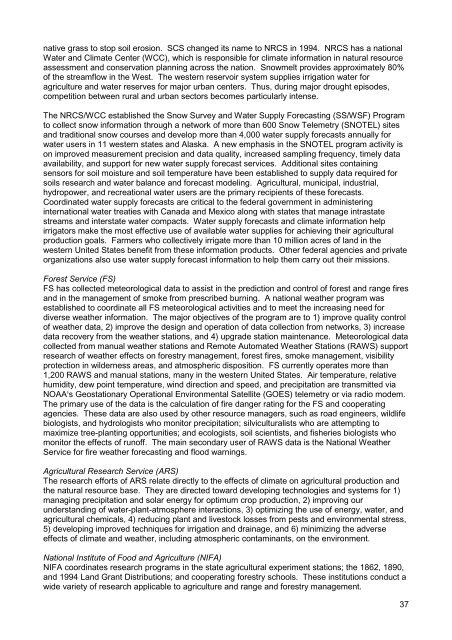Agricultural Drought Indices - US Department of Agriculture
Agricultural Drought Indices - US Department of Agriculture
Agricultural Drought Indices - US Department of Agriculture
Create successful ePaper yourself
Turn your PDF publications into a flip-book with our unique Google optimized e-Paper software.
native grass to stop soil erosion. SCS changed its name to NRCS in 1994. NRCS has a national<br />
Water and Climate Center (WCC), which is responsible for climate information in natural resource<br />
assessment and conservation planning across the nation. Snowmelt provides approximately 80%<br />
<strong>of</strong> the streamflow in the West. The western reservoir system supplies irrigation water for<br />
agriculture and water reserves for major urban centers. Thus, during major drought episodes,<br />
competition between rural and urban sectors becomes particularly intense.<br />
The NRCS/WCC established the Snow Survey and Water Supply Forecasting (SS/WSF) Program<br />
to collect snow information through a network <strong>of</strong> more than 600 Snow Telemetry (SNOTEL) sites<br />
and traditional snow courses and develop more than 4,000 water supply forecasts annually for<br />
water users in 11 western states and Alaska. A new emphasis in the SNOTEL program activity is<br />
on improved measurement precision and data quality, increased sampling frequency, timely data<br />
availability, and support for new water supply forecast services. Additional sites containing<br />
sensors for soil moisture and soil temperature have been established to supply data required for<br />
soils research and water balance and forecast modeling. <strong>Agricultural</strong>, municipal, industrial,<br />
hydropower, and recreational water users are the primary recipients <strong>of</strong> these forecasts.<br />
Coordinated water supply forecasts are critical to the federal government in administering<br />
international water treaties with Canada and Mexico along with states that manage intrastate<br />
streams and interstate water compacts. Water supply forecasts and climate information help<br />
irrigators make the most effective use <strong>of</strong> available water supplies for achieving their agricultural<br />
production goals. Farmers who collectively irrigate more than 10 million acres <strong>of</strong> land in the<br />
western United States benefit from these information products. Other federal agencies and private<br />
organizations also use water supply forecast information to help them carry out their missions.<br />
Forest Service (FS)<br />
FS has collected meteorological data to assist in the prediction and control <strong>of</strong> forest and range fires<br />
and in the management <strong>of</strong> smoke from prescribed burning. A national weather program was<br />
established to coordinate all FS meteorological activities and to meet the increasing need for<br />
diverse weather information. The major objectives <strong>of</strong> the program are to 1) improve quality control<br />
<strong>of</strong> weather data, 2) improve the design and operation <strong>of</strong> data collection from networks, 3) increase<br />
data recovery from the weather stations, and 4) upgrade station maintenance. Meteorological data<br />
collected from manual weather stations and Remote Automated Weather Stations (RAWS) support<br />
research <strong>of</strong> weather effects on forestry management, forest fires, smoke management, visibility<br />
protection in wilderness areas, and atmospheric disposition. FS currently operates more than<br />
1,200 RAWS and manual stations, many in the western United States. Air temperature, relative<br />
humidity, dew point temperature, wind direction and speed, and precipitation are transmitted via<br />
NOAA=s Geostationary Operational Environmental Satellite (GOES) telemetry or via radio modem.<br />
The primary use <strong>of</strong> the data is the calculation <strong>of</strong> fire danger rating for the FS and cooperating<br />
agencies. These data are also used by other resource managers, such as road engineers, wildlife<br />
biologists, and hydrologists who monitor precipitation; silviculturalists who are attempting to<br />
maximize tree-planting opportunities; and ecologists, soil scientists, and fisheries biologists who<br />
monitor the effects <strong>of</strong> run<strong>of</strong>f. The main secondary user <strong>of</strong> RAWS data is the National Weather<br />
Service for fire weather forecasting and flood warnings.<br />
<strong>Agricultural</strong> Research Service (ARS)<br />
The research efforts <strong>of</strong> ARS relate directly to the effects <strong>of</strong> climate on agricultural production and<br />
the natural resource base. They are directed toward developing technologies and systems for 1)<br />
managing precipitation and solar energy for optimum crop production, 2) improving our<br />
understanding <strong>of</strong> water-plant-atmosphere interactions, 3) optimizing the use <strong>of</strong> energy, water, and<br />
agricultural chemicals, 4) reducing plant and livestock losses from pests and environmental stress,<br />
5) developing improved techniques for irrigation and drainage, and 6) minimizing the adverse<br />
effects <strong>of</strong> climate and weather, including atmospheric contaminants, on the environment.<br />
National Institute <strong>of</strong> Food and <strong>Agriculture</strong> (NIFA)<br />
NIFA coordinates research programs in the state agricultural experiment stations; the 1862, 1890,<br />
and 1994 Land Grant Distributions; and cooperating forestry schools. These institutions conduct a<br />
wide variety <strong>of</strong> research applicable to agriculture and range and forestry management.<br />
37

















